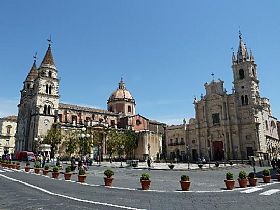Catania

The second largest city in Sicily, Catania is a vibrant place. Located between Messina and Siracusa, it boasts an important university, an active nightlife, and a bustling city center. There is also a seafront to enjoy and the CircumEtnea train for excursions to Mt. Etna.
Founded in the 8th century BC by the Greeks, it was taken over by the Romans, whose presence is still seen with the ruins that abound, particularly the Roman Amphitheater in Piazza Stesicoro. Catania flourished during the Renaissance and was the site of the first university in Sicily. Unfortunately, it suffered seriously in the eruption of its neighboring vulcano in 1693 and was rebuilt with Baroque flair while enlarging the piazzas and adding wide boulevards, giving the historic center a unique look. Another unusual feature is that many of buildings are built out of lava rock!
The hub of the city is Piazza Duomo, where the highlight is, of course, the Duomo itself. The cathedral is dedicated to St. Agatha, was constructed over top of the ancient Roman baths using materials scavenged from the Roman amphitheater. There are ornate chapels and lovely frescoes, and three Bourbon rulers are buried here - Frederick II, Louis and Frederick III. The famous opera composer, Vincenzo Bellini, a Catania native, is also laid to rest in the cathedral.
The Diocesan Museum, with treasured religious works, and the so-called Palazzo degli Elefanti, a palace built in 1696 that houses the city hall, are also found in the Piazza Duomo. The Municipio palace has painted salons. The beloved Elephant Fountain, which is a symbol of the city, is found in the midst of the piazza, as well.
Catania is a lively city with shopping streets, like Via Etnea, a mercato, and still holds a fish market, showing that its port is still important even after centuries of making the city a commercial center. There are streets stands that sell lemon soda, orange soda and hand-grated ice granitas.
This is a musical city - with a museum paying homage to the famous composer, Bellini. The Bellini Theater is open for performances from October through June. Of note to see is the Castello U rsino, built by Holy Roman Emperor Frederick II and Palazzo Biscari, an opulent Baroque palazzo still owned by the noble Paterno' Castello family. The Federico II School has a program of cultural events and his housed in a Baroque building in Via Garibaldi.
The beaches are worthy for a day of sun and surf. The so-called Riviera dei Ciclopi stretches out north of the city, while the Playa is a golden-sand expanse with Mt. Etna looming behind in the background. There are also reefs and rocky shores to enjoy along the Catania coast.
Most people consider Catania to be the cultural capital of Sicily, a fairly genteel and user-friendly city with quiet quarters, buzzing city life, interesting streets, great restaurants and much to do. It's a good central point for excursions inland as well as to the Greek sights and the coast.
Browse carefully selected home rentals in Sicily.

 Amalfi Coast
Amalfi Coast Sorrento Coast
Sorrento Coast Tuscany
Tuscany Cilento National Park
Cilento National Park Lake Como
Lake Como Rome and Latium
Rome and Latium Umbria
Umbria Capri and Ischia
Capri and Ischia Venice
Venice Puglia (Apulia)
Puglia (Apulia) Liguria
Liguria Sicily
Sicily Lake Maggiore
Lake Maggiore Lombardy
Lombardy Sardinia
Sardinia Lake Garda
Lake Garda Abruzzo and Marche
Abruzzo and Marche Calabria
Calabria


Been there? Done that? Share your experience and tips!
Haven't visited yet? Have questions about Catania? Ask them here!